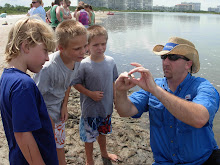Just a little background, sawfish are a type of elasmobranch, which include sharks, rays and skates. They are characterized by a long, flattened, toothed "saw" or rostrum, a flattened head and trunk, and a shark-like appearance and manner of swimming. Habitat destruction and overfishing have caused global sawfish populations to plummet in past decades. The IUCN lists all seven species critically endangered. The smalltooth sawfish (Pristis pectinata) is one of two species that can be found in Florida waters, and it too has seen rapid declines in the past. In fact it is the first marine fish species to receive protection under the Endangered Species Act. Its current range is primarily limited to the coastal waters off southwest Florida. It is illegal to catch, harm, or harass a sawfish. However, both commercial and recreational fishermen still catch sawfish while fishing for other species. The National Marine Fisheries Service and the Smalltooth Sawfish Recovery Team have developed guidelines for fishermen that explain how to safely handle and release any sawfish they catch. For example...What is the safest way to release a captured sawfish?
Sawfish Safe Release Guidelines
If hooked:
•Keep the sawfish in the water at all times
•If it can be done safely, untangle the line if it is wrapped around the saw and remove as much of the line as possible.
•Cut the line as close to the hook as possible.
•Do not handle the animal or attempt to remove any hooks on the saw unless you have a long-handled dehooker.
If tangled in a net:
•Make every effort to free the animal from the net with minimal additional stress or injury.
•Keep sawfish, especially the gills, in the water as much as possible.
•Try to remove all the netting and release the animal quickly.
•DO NOT REMOVE THE SAW!
Be sure to look for the program's educational signage at boat ramps, marinas, and other water access points in the region.
Of equal importance is reporting any encounters you have with sawfish, whether you catch one yourself, or just see one. Remember, they are endangered species, and any information you can provide is invaluable to recovery efforts. As quoted by the museum, "sawfish sighting reports are a very important tool for the monitoring of the population. They assist in the evaluation of the species abundance and habitat range, helping us not only to estimate the population size but also to identify their habitat preferences. As a result, the sawfish sighting reports are vital for the success of the Smalltooth Sawfish Recovery Plan."
The National Sawfish Encounter Database (NSED) is housed at the Florida Museum of Natural History and keeps track of sawfish encounters around the country. Anyone who encounters a sawfish can fill out their sawfish reporting form or contact George H. Burgess or John Waters at (352) 392-2360.
For more details on reporting sawfish encounters visit:
http://www.flmnh.ufl.edu/fish/sharks/sawfish/SRT/SFFLYER.PDF






No comments:
Post a Comment